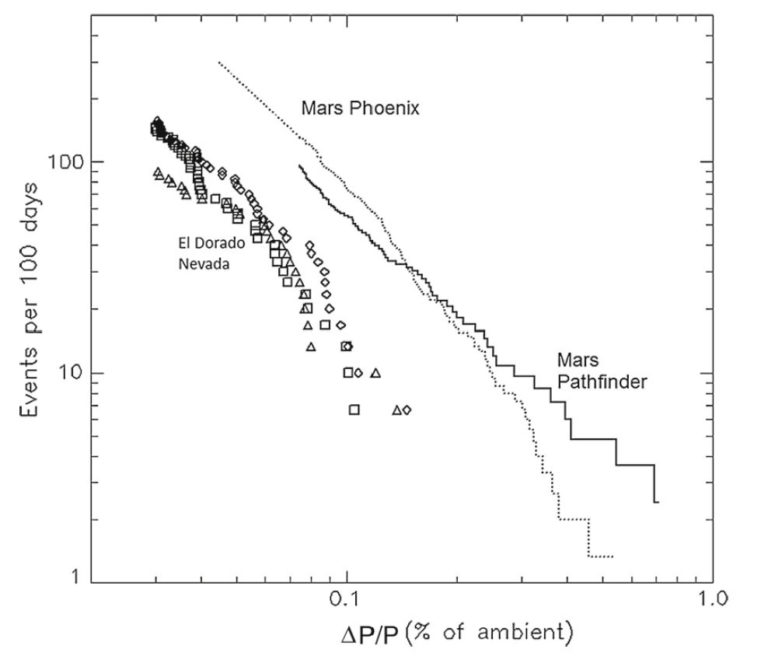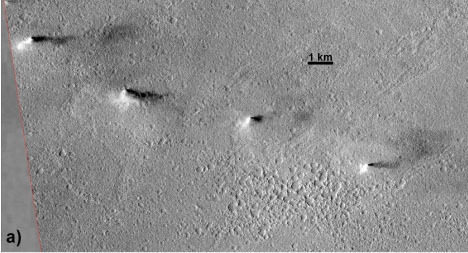Ralph Lorenz • Nov 02, 2015
A Roundup of Dust Devil Research
“And so the hours dragged by until the sun stood dead above our heads, a huge white ball in the noon sky, beating, blazing down, and then it happened – suddenly, a whirlwind! Twisting a great duststorm up from the earth, a black plague of the heavens filling the plain, ripping the leaves off every tree in sight, choking the air and sky. We squinted hard and took our whipping from the gods.”
Thus speaks a sentry in the play 'Antigone', written by Sophocles in Greece around 450 BCE, capturing a scene that many dust devil researchers two and a half millennia later will doubtless appreciate. As long as people have been writing anything, they've been writing about dust devils.
Dust devils are among the most prominent dynamic phenomena observed on the surface of Mars, and are common in dusty regions of Earth. Dust devils are whirlwinds or vortices made visible by lofting dust from the surface. They are caused by strong heating of the ground, which forms a layer of hot, buoyant air when the ambient wind is not too strong. It's usually sunlight that heats the ground, but some related features can form in forest fires or even on fresh, hot volcanic ash plains. The hot air rises in plumes, making a converging flow near the ground. This convergence intensifies any rotation in the ambient wind to form a vortex, much like the vortex that forms in a draining sink.
Dust devils have some features in common with tornadoes, although these are powered by storm systems aloft rather than direct solar heating; their funnels also descend from the cloud layer rather than rising from the ground. Hurricanes, on the other hand, are driven by the warm (ocean) surface more analogously to dust devils, but use moist air (in effect, steam) rather than dry air as their working fluid. Hurricanes are also large enough that the Earth's rotation determines their direction of spin, whereas the rotation of dust devils has a random direction.
Dust devils are usually just an interesting desert curiosity, and sometimes a nuisance at soccer games or picnics. But occasionally, they can be deadly. In the process recently of researching a historical review of dust devils I found a number of instances where people have been killed by dust devils, due to light buildings collapsing or to vehicle, aircraft or parachute accidents. Damage to light structures, fires caused by items lofted onto power lines, and injuries (including children with broken limbs when the 'bouncy castle' they were playing on was lifted across a busy street) are not uncommon. By deaths and dollars overall, dust devils are between a hundred and a thousand times less dangerous than tornadoes, but this is little consolation to those involved.
On Mars, dust devils may be larger, but are probably not terribly dangerous. Indeed, they can actually be useful. Dennis Reiss and I showed last year that the "clearing events" that swept dust off the solar panels of the Spirit rover and rejuvenated its power supply occurred with a frequency consistent with that of encountering vortices of an intensity strong enough to lift dust in Martian conditions (known from laboratory tests). The clearing events also coincided with the onset of dust devil season.
Dust devil research is at an exciting stage, moving from "trophy hunting" and "stamp collecting" to more systematic and synthetic investigations. By "trophy hunting" I mean isolated and sometimes poorly-documented meteorological measurements collected by adventurous chasing of dust devils in pickup trucks – jolly good fun, of course, and providing important example data on the basic properties of vortices, but susceptible to vehicle noise and selection biases (people like to chase the biggest, slowest devils). "Stamp collecting" refers to surveys of dust devil activity, either by thirsty enterprise of sitting out in the heat and watching for weeks with binoculars, or trawling through reams of spacecraft images. These efforts make good student projects! But in many cases, the statistics have been collected without much direction in their analysis.
In recent years, however, the growing body of information from these studies, together with some more elaborate analysis, and the insights from ever-improving numerical simulations ("Large-Eddy Simulations" or LES -- like weather-forecasting models, but at a much smaller scale) have started to link the various surveys and in-situ measurements into a more coherent picture. Much of this work was presented at a week-long dedicated workshop in February 2015 at the International Space Science Institute in Bern, Switzerland, and the proceedings of that workshop are being written up into a formidable book.

For example, dust devils are usually quite small, a few meters in diameter, and last a few minutes. They can, however, be a hundred meters or more (or several hundred meters on Mars) and last for hours. But what does "usually" mean? There are many more small devils than large ones, and so the average size one sees depends on how long one looks. We now know that like the size of impact craters, or the size of earthquakes (or for that matter forest fires, and shocks in stock prices) the skewed distribution of dust devil diameters, or the intensity of the pressure drops in their centers, can be described by a mathematical function called a power law.

It emerges that dust devils are not quite random. We are getting close to the stage of being able to predict, at least on a statistical basis, the circumstances when devils may occur. Dust devils are most common in early afternoon in summer, and seem to like gentle winds more than total calm or strong winds. Their height may be limited to the thickness of the planetary boundary layer (the lowest few kilometers in the atmosphere). It is now recognized that dust devils can have a characteristic spacing that also relates to the planetary boundary layer thickness, and that the appearance of dust devils may be diagnostic of the ground conditions: taller, more perfect cylindrical columns are characteristic of flat terrain, and more conical devils tend to form over rougher ground. Dust devils tend to have straighter paths, and 'lean over' in stronger winds. They tend to travel at close to the ambient windspeed, so observations of dust devils are one of the few available tools to measure winds on Mars from orbit.

What of the future? One avenue of research that is seeing a renaissance is the electric fields generated by dust devils. These were known even in the 1860s, and occasional 'stamp collecting' studies have shown that fields of 10s of thousands of volts per meter can be generated. But now with the prospect of electric field measurements at Mars with an instrument on the European ExoMars lander Schiaparelli, systematic field experiments and numerical simulations are bringing a fuller understanding of dust devil electrical effects. Electrical discharges could be important in the formation of soil oxidants such as the perchlorates found by the Phoenix lander.
Also, the upcoming InSight mission, to be launched next year, will also be able to study dust devils with a camera and meteorology instrumentation. And, as we will describe in a future blog entry, its seismometer may open a new window into dust devil studies.


 Explore Worlds
Explore Worlds Find Life
Find Life Defend Earth
Defend Earth

